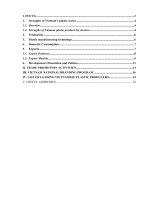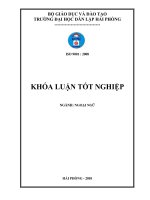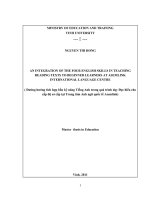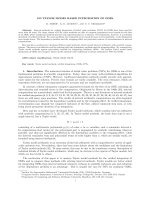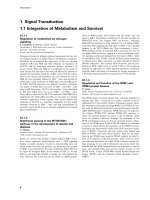Sector integration workshop 300323pdf
Bạn đang xem bản rút gọn của tài liệu. Xem và tải ngay bản đầy đủ của tài liệu tại đây (13.29 MB, 93 trang )
09:30 – 10:00
Welcome coffee
10:00 – 11:30
1st session: Integrated and flexible energy systems, The power of Heat
• Lelde Kiela -Vilumsone, Team Leader - End-use sectors, impacts and
methodologies (Renewables and Energy System Integration Policy (ENER.C.1))
• Rodrigo Barbosa, Manager, Long-term planning (ENTSO-E)
• Pauline Lucas, Policy Director (Euroheat & Power)
• Raymond C. Decorvet, Senior Account Executive, Global Business Development ETES,
CO2 Heat-Pumps & Power Storage (LDES) (MAN Energy Solutions)
10:00 – 11:30
Coffee break
11:45 – 13:00
2nd session: Innovative DHC and other solutions for sustainable integrated energy systems in
Europe: concrete examples
• Pernille Salomonsen, Energy & Development Consultant (Albertslund Forsyning)
• Thibaut Wissocq, Researcher scientist (CEA)
• Guillaume Bardeau, R&D Engineer (Renewable heating & Cooling) (EIFER)
13:00 – 14:00
Lunch
Role of Energy System Integration
Workshop on integrated and flexible
energy systems: the untapped potential of DHC
Brussels, 30 March 2023
Lelde Kiela Vilumsone
Renewables & Energy System Integration Policies
Directorate-General for Energy
A fast-changing policy context
Climate neutrality in 2050
1
Green Deal &
Climate Law
Higher level of biodiversity
protection
Biodiversity
Strategy
Climate Target
Plan
-55% GHG in 2030
38-40 % RES share
REDII revision
HIGH
ENERGY
PRICES
Offshore RES
Strategy
2
3 pillars for the energy system
1/ Efficiency & circularity
2/ RES-E & electrification
3/ RES fuels (incl. hydrogen)
Renovation
Wave
Offshore RES as an EU
priority
2
Energy
System
Integration
& Hydrogen
Strategies
Promote efficiency and
renewables in buildings
RepowerEU - focus on renewable energy
• Increase the EU 2030 target for renewable
energy from 40% to 45%
• Deployment of wind and solar energy in
power sector
• Accelerated installation of heat pumps (10
mln by 2027)
• Renewable hydrogen accelerator (10
mln t. of domestic production and imports
by 2030)
Estimated 69% of electricity to be generated from RES by 2030
* Commission proposals
Approach to Energy System integration
Key role of system integration in delivering the European Green Deal
and the RepowerEU objectives
More circular &
energy efficient
energy system
Electrification
based on
renewables
Renewables
and low carbon
fuels, hydrogen
EU strategy on energy system integration (2020)
EU hydrogen strategy for a climate-neutral Europe (2020)
Holistic
approach consumers,
digitalisation &
infrastructure
More flexible energy system
What are the challenges?
Full implementation of the Electricity Market legislation (provisions
on flexibility)
Accelerating modernisation of the grids (uptake of smart meters)
Adoption of the revised Renewable Energy Directive (provisions
on heating and cooling, access to data on RES)
Revision of the Electricity Market Design (March 2023)
Policy recommendations for uptake of energy storage (March
2023)
* Commission proposals
Revision of Electricity Market Design
Increasing renewables share to be balanced with non-fossil
flexibility - demand response and storage
A new definition on flexibility of electricity system
NRAs to issue a report every 2 years on the needs for flexibility in the
electricity system in view of achieving both security of supply and
decarbonisation objectives.
Member States to define an indicative national objective for demand
response and storage.
MS may use support schemes for available non-fossil flexibility
capacity.
Electricity Market Reform for consumers and annex (europa.eu)
* Commission proposals
Commission recommendation on storage
Enhanced role of storage in energy system integration
Facilitate permit granting and further exploiting potential of energy
storage in design and operation of the networks
Consider specific aspects of energy storage in designing network
charges & tariff schemes, tax measures
Address challenges to predictability of revenue flow to facilitate access
to finance
Importance of behind-the-meter storage
More transparency of data to facilitate investment decisions
Commission recommendations on how to exploit the potential of energy storage (europa.eu)
* Commission proposals
Actions in heating and cooling sector
RepowerEU: Double deployment rates for heat pumps &
develop district heating systems to replace fossil fuels
30 million newly installed heat pumps in 2030, 10 million units in
the next 5 years
Develop/ modernise district heating systems to replace fossil
fuels in individual heating (in cities, urban areas)
Accelerate deployment and integration of: a) large-scale heat
heat pumps, b) geothermal and c) solar thermal energy
Exploit industrial heat whenever available
REDII revision – Shifting to modern, RES based DHC & buildings
DHC:
• Increased indicative target to
2.2 percentage points
• Stronger consumer
information and network
access requirements
• Stronger coordination with
other energy networks to
facilitate system integration
• Coordination framework to
harness the potential
sources of waste heat and
cold
Buildings:
• Indicative 49% renewable
energy target to monitor
efforts and progress
• Training and skills
• Complementary to EED
and EPBD
Enabling framework for waste heat and ESI
Strengthening and enabling DHC role in Energy System Integration by
requirements to establish national frameworks:
for waste heat/cold utilisation (Article 24(6))
for cooperation with electricity, gas and other energy grids (Article 24(8))
Action Plan on Heat Pumps
Aimed at four areas of action:
Creating a platform/accelerator/partnership of the Commission,
Member States and the sector
Communication on available Heat Pump solutions and a
dedicated Heat Pumps skills partnership
Ongoing legislative work – adoption and implementation
More accessible financing – through enhanced cooperation with
financing community and use of EU funding
=> Planned adoption Q4 2023, stakeholder consultation activities in Q2 2023
Thank you!
© European Union 2020
Unless otherwise noted the reuse of this presentation is authorised under the CC BY 4.0 license. For any use or reproduction of elements that are
not owned by the EU, permission may need to be sought directly from the respective right holders.
Ten-Year Network Development Plan (TYNDP)
Promoting projects to support delivering the energy transition
Process of European
Projects of Common
Interest led by the
European Commission
TYNDP
The TYNDP Package and the high-level process behind it
Defining up to three
most plausible futures,
which we call Scenarios
Project collection
and identification
Identification of the
needs based on our scenarios
Projects of common
Interest Process
Cost benefits
analysis of projects
2
TYNDP - Scenarios
Exploring different pathways with regard to the identified ‘high-level drivers’, with the purpose of covering uncertainty in evolution of energy infrastructure
High-level drivers
Deviation Scenarios
2030
2040
2050
National Trends +
National Trends + Scenario
• The aggregation of national approaches that reaches EU target,
• Relies on data collection process from TSOs based on NECPs and national strategies
• Aims at anticipating national strategies to be implemented to reach EU targets (which will be part of updated
NECPs)
Deviation Scenarios (Distributed Energy ‘DE’ & Global Ambition ‘GA’)
• Deviation from National Trends + scenario to capture uncertainties
• Deviation is based on the storyline which relies on both TSO & Stakeholder input & consultation
Higher European
autonomy with
renewable and
decentralised focus
Aggregation of
national policies and
strategies as stated
end of 2020 and
being updated for
new targets
Global economy with
centralised low
carbon and RES
options
3
TYNDP – Identification of System Needs
Gaps and opportunities for Europe’s power system in 2030 and 2040
Map for the 2040 study
4
TYNDP – CBA
Main indicators
5
Our values define who we are, what we stand for and how we behave.
We all play a part in bringing them to life.
EXCELLENCE
TRUST
INTEGRITY
TEAM
We deliver to the
highest standards.
We provide an
environment in
which people can
develop to their full
potential.
We trust each
other, we are
transparent and we
empower people.
We respect
diversity.
We act in the
interest of
ENTSO-E
We care about
people. We work
transversal and we
support each other.
We celebrate
success.
FUTURE
THINKING
We are a learning
organisation.
We explore new
paths and solutions.
We are ENTSO-E
6
DHC, the missing link of flexible
energy systems:
perspective from Fit for 55 and
beyond
RES-DHC and REWARDHeat Policy Workshop
Pauline Lucas, Policy Director of Euroheat & Power
30/03/2023
The energy system is undergoing significant
transformations that calls for flexibility & integration
Climate and
geopolitical crisises
Electrification Policies &
growing shares of variable
renewable electricity
Need for development of new
electricity grid infrastructure
EU energy system
under pressure
New policy
mandate
Why does it matter? (1)
Wind & PV variability require flexibility and optimization to make the most of RES.
Supply needs to meet demand in real time.
Germany Week 04.04.2022 – 11.04.2022
Why does it matter? (2)
We cannot (and should not) bet on one single energy carrier for all sectors.
Technologies that enable diversification of climate-neutral sources are needed.
H&C networks are integrated & flexible by nature
Multi-energy
system
Recovered heat from
industrial & tertiary activities
(~25% of the future DH
supply)
Absorb RES electricity & provide
balancing using large-scale
heat-pumps or e-boilers
RES heat sources
(Geothermal, solar thermal
Bioenergy, WtE)
Recover heat from H2
and nuclear production
The perfect
toolbox
Heat Pumps,
e-boilers
Thermal
Storage
LT heating &
cooling networks
High-efficiency
cogeneration
Fit for 55: unleashing flexible & integrated DHC
Boost waste heat uptake
• Waste heat accountable towards sub-sector
RES targets
• Coordination framework to foster recovery
• Mandatory waste heat recovery for data
centres above 1MW (only if technically &
economically feasible)
Promotion of system
integration
• Accounting of green electricity
towards H&C targets and DHC targets
• thermal storage target
• Coordination when planning energy
infrastructure
Beyond FF55? Electricity Market Design
DHC framework
• Gradual phase-in RES and WH with
new definition of efficient DHC
• Mandatory local heating & cooling
planning (45k citizens)
Increased share of
renewable
• ETS2 for all fossil fuels used in
buildings.
• Phase-out of fossil fuel boilers in
new & refurbished buildings by
2025/6 (EP)
• Targets for HP and solar, including
large-scale HP and solar thermal (EP)
